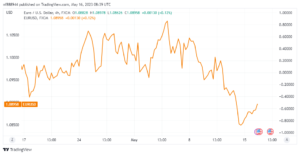After posting tiny rebound gains on Monday. The EURUSD has been trading sideways below 1.0900 early Tuesday. The pair’s technical outlook in the short term indicates a dearth of buying interest.
According to reports, ECB officials envision only one or two more rate hikes.
MNI stated on Monday, citing Euro system sources. That the European Central Bank (ECB) was most likely to hike key rates once or twice more during current tightening cycle. Meanwhile, the European Commission raised its inflation projection for 2023 to 5.8% from 5.6% earlier. The Euro is struggling to gain traction. As investors try to figure out if the ECB is nearing the end of its rate hiking cycle.
Markets are anticipating statistics on EU first-quarter GDP and US retail sales.
Later in the afternoon, Eurostat is expected to release a 0.1% increase in Eurozone GDP (GDP) in the first quarter. If this data is unfavorable, the Euro is expected to come under fresh bearish pressure as markets shift towards a less hawkish ECB stance.
Retail Sales data for April will be released in the second half of the day on the US economic calendar. Following a 0.6% decline in March, Retail Sales are expected to rise 0.7% in April. Investors are getting increasingly anxious about the US economy slowing, and the US Dollar (USD) may struggle to find demand if this data fails to demonstrate solid consumer activity, and vice versa.
Market players will also pay particular attention to Federal Reserve (Fed) officials’ comments. Raphael Bostic, President of the Atlanta Federal Reserve, told Bloomberg on Monday that if he could vote today, he would vote to keep interest rates the same in June. Richmond Fed President Thomas Barking, on the other hand, told the Financial Times that there was no reason to hike rates more if inflation continued or accelerated.
Markets are broadly persuaded that the Fed will maintain its policy rate in June, thus the potential negative impact of dovish Fed speak on USD performance should be limited.
EURUSD Technical Outlook
After the recent rally, the four-hour chart’s Relative Strength Index (RSI) indicator remains below 50. Indicating that EURUSD is staging a technical correction rather than beginning a new leg upward.
The pair is facing immediate resistance around 1.0900 (psychological level, static level). Followed by 1.0950 (Fibonacci 23.6% retracement of the last upswing. 200-period Simple Moving Average (SMA)) and 1.0990/1.1000 (100-period SMA, psychological level).

A four-hour closing below 1.0870 (Fibonacci 38.2% retracement) might entice sellers. In such case. EURUSD might find temporary support near 1.0850 (static level) before continuing its decline towards 1.0800.








